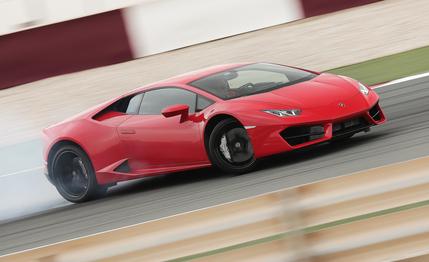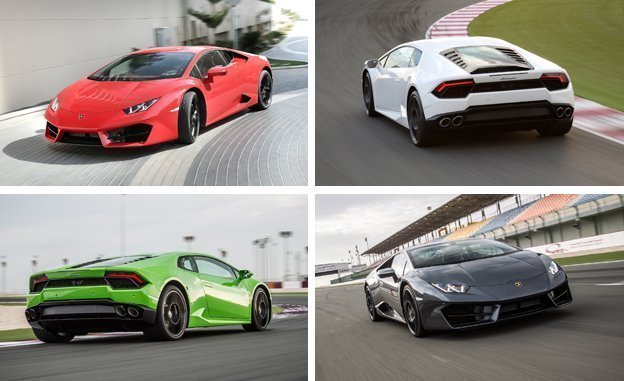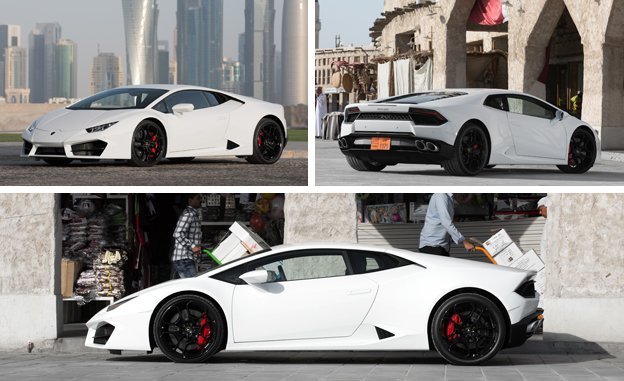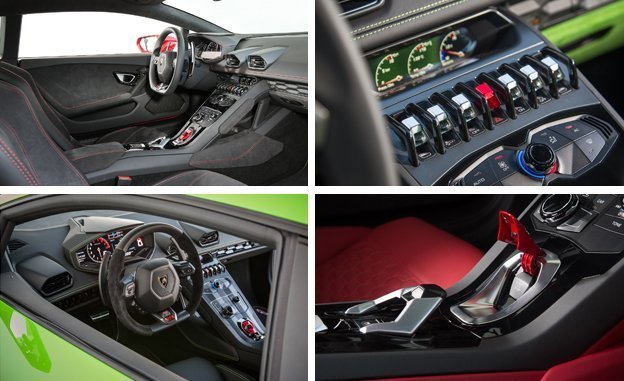
 First Drive Review
First Drive Review
As art imitates life, so the favor is returned. Virtual Lamborghinis have featured in many video games over the years, and now the Italian company seems to have developed a new model specifically for those who grew up with that genre's least realistic games, the ones that let you drift your virtual supercar with pixel-perfect precision at ridiculous speeds.
That’s certainly what we take from the technical briefing that introduces us to the new rear-wheel-drive Huracán LP580-2, as well as from our drive at the Losail circuit in Qatar. Maurizio Reggiani, Lamborghini’s R&D boss, gave a presentation in which he mentioned power oversteer in practically every other sentence. He assured us that the new car has been designed to flatter the skills of even modestly talented drivers, his words delivered against a video backdrop of Huracáns drifting at such outlandish angles as to make us believe Ken Block has at least one Italian cousin.


While this new rear-drive Huracán is a cheaper entry into Lambo ownership, it's also being pitched as more involving to drive than the existing LP610-4, trading some performance for the excitement and adjustability that comes from having more power than grip. A rear-wheel-drive Huracán was always part of the plan, unlike the rear-wheel-drive Gallardo, which was pretty much a driveshaft-removal job. Shedding the LP610's electronically controlled clutch pack as well as its propeller shaft, front differential, and related hardware saves a relatively modest 73 pounds in weight, but it also delivers some definitive differentiation over the Audi R8 that shares most of the baby Lambo’s structure and powertrain.
As the name suggests, the LP580’s mid-mounted 5.2-liter V-10 has been slightly downtuned, now delivering 572 horsepower. Both the engine speed at which peak power arrives and the fuel cutoff have fallen by 250 rpm to 8000 rpm and 8500 rpm compared with the 602-hp LP610-4. When we speculated as to whether this modest reduction in output had been done to ensure the cheaper, lighter car was not quicker than its $39,100-dearer sister, nobody looked too outraged, although Reggiani says the engine has also been digitally retuned to have a flatter torque curve better suited to, you've guessed it, going sideways.
Performance losses are minimal. Figure on a zero-to-60-mph time 0.2 second behind the regular car, which we timed at 2.5 seconds. The quoted top speed of 199 mph is 3 mph off the 610’s terminal velocity, which is unlikely to be an issue to anyone but latter-day moonshine runners.
We, however, didn’t get a chance to drive the LP580-2 on the road, only on the Losail circuit located at the edge of the desert near Doha. Having seen Qatar's roads on our way to the track, we can report this as no great loss, as the entire country seems to be a construction site, sand, or some combination of both. But it does mean that we traveled all the way to the Middle East for the grand total of 16 laps of the 3.4-mile track, best known for hosting a round of the MotoGP championship. But don't worry—we made ’em count.


The LP580-2 is the only Lamborghini whose pre-tax and pre-destination MSRP scoots under the $200,000 mark, albeit by less than the cost of one of the brand’s many logo jackets, but the good news is that very few people will realize you are driving what amounts to the base version. Apart from slightly redesigned bumpers, it looks identical to the LP610-4, projecting an equal amount of wedgy aggression. The cabin is identical, with the exterior's edge-intensive design theme carried throughout—even the steering wheel has corners—and the underlying Audi architecture well hidden.
The decreases on both sides of the power-to-weight equation have left the LP580 feeling exactly as rapid as the 610—in a word, very. The engine remains a masterpiece, one that growls, snarls, and ultimately screams its way toward its stratospheric redline—and with the sort of perfectly proportional throttle response that makes it feel as if you can add horsepower one pony at a time. Experiencing it again is instant vindication of Lamborghini’s decision to stand against the widespread move to turbocharging, and we remain happy to trade the naturally aspirated engine’s relative lack of low-end torque for its sonorous high-revving fervor, on a track at least.
As in the Huracán LP610-4, there are three switchable “ANIMA” dynamic modes for the steering, engine, gearbox, and (optional) adjustable dampers. Strada (road) and Corsa (track) modes remain as before, but the intermediate Sport setting has been repurposed into what’s basically a drift mode, unhanding the leash of the Huracán’s stability control to allow the greatest amount of slip and actually softening the adaptive dampers to help with oversteer-inducing weight transfer. The dual-clutch automatic gearbox shifts quickly and cleanly when instructed to do so by the long paddles that sit behind the steering wheel, upshifting unprompted if you reach the fuel cutoff in either Strada or Sport modes but bouncing against the limiter if you reach it in Corsa.


This magic sideways mode works pretty much as promised. With Sport engaged, you power into a turn to find an initial dose of understeer, this acting as a sort of dynamic liability waiver. Indicate consent by continued application of the throttle and the Huracán transitions into oversteer with the grace of a drifting swan, the back end stepping out with the deference of an attentive valet. Then keep the gas on and the steering pointing in the right direction and the Lamborghini will hold the slide for practically as long as you want—and certainly long enough to make you feel like a driving hero. Every part of the chassis has been adapted for this task, the front-suspension geometry tweaked to improve the steering's caster effect to help the front tires stay locked to the direction of travel. The upshot is a near-600-hp supercar that's as easy to drift on a bone-dry racetrack as a Mazda Miata is on a frozen lake.
It's a really neat trick; one we used a fair number of our allotted 16 laps experiencing, and we can confirm that the Huracán is equally happy to do it even in faster third- and fourth-gear turns. But while you can almost persuade yourself that this is merely natural affirmation of your own God-given talent, you do ultimately realize this is just a digitally delivered simulacrum, especially in the way the electric-power-assisted steering lightens and tightens as course-correcting brake inputs are sent to the front end—and in the system's tolerance for the sort of excess throttle inputs that should fire the Huracán backward into one of Losail's gravel traps.
We actually preferred the Huracán in its more aggressive Corsa mode, which works to maximize grip over slip while still allowing the occasional slide, and which showed the rear-driver is capable of finding adjective-stretching traction despite its relative lack of driven wheels. It's not as fast as the LP610-4 around a track—elementary physics sees to that—but it's more exhilarating to drive hard, rawer and more challenging. For those who accused the Huracán of being more about speed than experience when it launched, this new variant stands as an eloquent riposte.